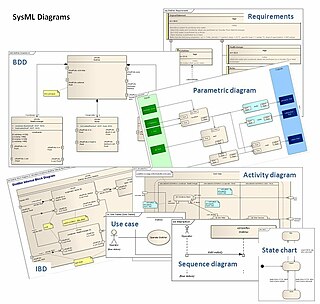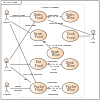Related Research Articles

The Object Management Group (OMG) is a computer industry standards consortium. OMG Task Forces develop enterprise integration standards for a range of technologies.

The Unified Modeling Language (UML) is a general-purpose, developmental modeling language in the field of software engineering that is intended to provide a standard way to visualize the design of a system.
The XML Metadata Interchange (XMI) is an Object Management Group (OMG) standard for exchanging metadata information via Extensible Markup Language (XML).
Model Driven Architecture (MDA) is a software design approach for the development of software systems. It provides a set of guidelines for the structuring of specifications, which are expressed as models. Model Driven Architecture is a kind of domain engineering, and supports model-driven engineering of software systems. It was launched by the Object Management Group (OMG) in 2001.

Objecteering is a UML and MDA CASE tool edited by Objecteering Software, a subsidiary of Softeam.

A metamodel or surrogate model is a model of a model, and metamodeling is the process of generating such metamodels. Thus metamodeling or meta-modeling is the analysis, construction and development of the frames, rules, constraints, models and theories applicable and useful for modeling a predefined class of problems. As its name implies, this concept applies the notions of meta- and modeling in software engineering and systems engineering. Metamodels are of many types and have diverse applications.
Object-oriented analysis and design (OOAD) is a technical approach for analyzing and designing an application, system, or business by applying object-oriented programming, as well as using visual modeling throughout the software development process to guide stakeholder communication and product quality.

Unicom System Architect is an enterprise architecture tool that is used by the business and technology departments of corporations and government agencies to model their business operations and the systems, applications, and databases that support them. System Architect is used to build architectures using various frameworks including TOGAF, ArchiMate, DoDAF, MODAF, NAF and standard method notations such as sysML, UML, BPMN, and relational data modeling. System Architect is developed by UNICOM Systems, a division of UNICOM Global, a United States-based company.
I-Logix was a leading provider of Collaborative Model driven development (MDD) solutions for systems design through software development focused on real-time embedded applications. Founded in 1987, the Andover, Massachusetts-based company product line enhanced collaboration among engineers, graphically modeling the requirements, behavior, and functionality of embedded systems. In addition, I-Logix was a member of the UML Partners, a group devoted to the development of the Unified Modeling Language (UML).
Model-driven engineering (MDE) is a software development methodology that focuses on creating and exploiting domain models, which are conceptual models of all the topics related to a specific problem. Hence, it highlights and aims at abstract representations of the knowledge and activities that govern a particular application domain, rather than the computing concepts.

The Systems Modeling Language (SysML) is a general-purpose modeling language for systems engineering applications. It supports the specification, analysis, design, verification and validation of a broad range of systems and systems-of-systems.
Cris Kobryn (1952) is an American technologist, system architect and entrepreneur who specializes in advanced software and systems development.
Rational Rhapsody, a modeling environment based on UML, is a visual development environment for systems engineers and software developers creating real-time or embedded systems and software. Rational Rhapsody uses graphical models to generate software applications in various languages including C, C++, Ada, Java and C#.

Papyrus is an open-source UML 2 tool based on Eclipse and licensed under the EPL. It has been developed by the Laboratory of Model Driven Engineering for Embedded Systems (LISE) which is a part of the French Alternative Energies and Atomic Energy Commission (CEA-List).
SysML Partners is a consortium of software tool vendors and industry leaders organized in 2003 to create the Systems Modeling Language (SysML), a dialect of UML customized for systems engineering. The consortium was founded and organized by Cris Kobryn, who previously chaired the UML 1.1 and UML 2.0 specification teams, and Sandy Friedenthal, chair of the OMG Systems Engineering Special Interest Group. The SysML Partners defined SysML as an open source specification, and their specifications include an open source license for distribution and use.

CoFluent Design is a supplier of electronic system-level (ESL) modeling and simulation software. CoFluent is headquartered in Nantes, France, and has sales offices in Paris, France, San Jose, California, and Tokyo, Japan.

UModel is a UML software modeling tool from Altova, the creator of XMLSpy. UModel supports all 14 UML 2 diagram types and adds a unique diagram for modeling XML Schemas in UML. UModel also supports SysML for embedded system developers, and business process modeling for enterprise analysts. UModel includes code engineering functionality including code generation in Java, C#, and Visual Basic, reverse engineering of existing applications, and round-trip engineering.
Sparx Systems is an Australian software company founded by Geoffrey Sparks in 1996 in Creswick, Victoria in Australia, known for the development of the Unified Modeling Language tool Enterprise Architect.

Sparx Systems Enterprise Architect is a visual modeling and design tool based on the OMG UML. The platform supports: the design and construction of software systems; modeling business processes; and modeling industry based domains. It is used by businesses and organizations to not only model the architecture of their systems, but to process the implementation of these models across the full application development life-cycle.
Model-based systems engineering (MBSE), according to the International Council on Systems Engineering (INCOSE), is the formalized application of modeling to support system requirements, design, analysis, verification and validation activities beginning in the conceptual design phase and continuing throughout development and later life cycle phases. MBSE is a technical approach to systems engineering that focuses on creating and exploiting domain models as the primary means of information exchange, rather than on document-based information exchange. MBSE technical approaches are commonly applied to a wide range of industries with complex systems, such as aerospace, defense, rail, automotive, manufacturing, etc.
References
- ↑ PivotPoint Technology. "Our Company" . Retrieved 2009-08-27.
- ↑ SD Times. "SD Times 100" . Retrieved 2009-08-27.
- ↑ PRLog.org. "SysML Partners Honored ..." Retrieved 2009-08-27.
